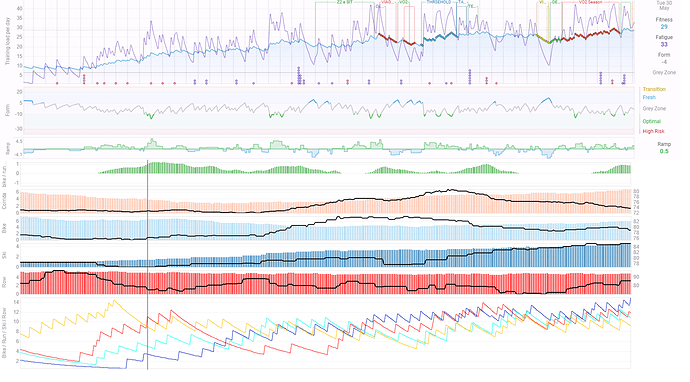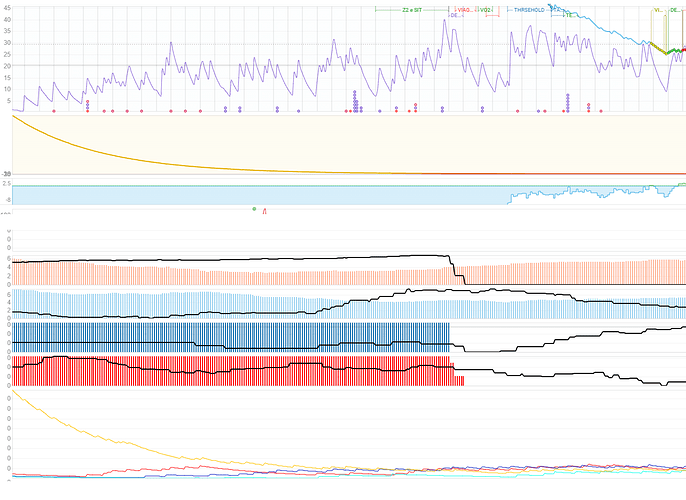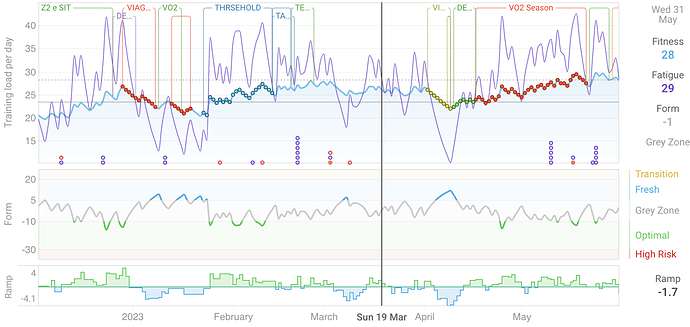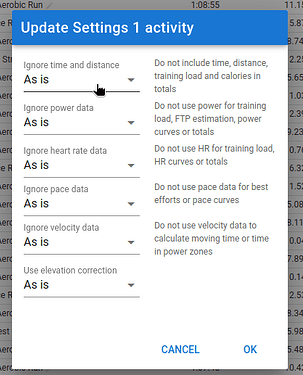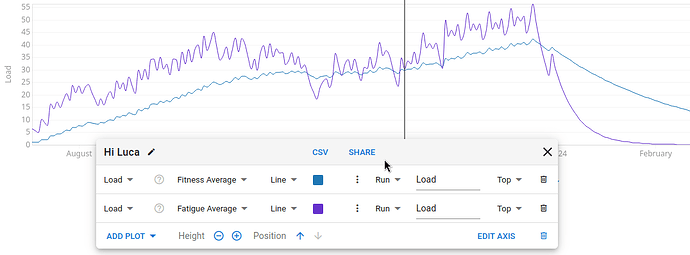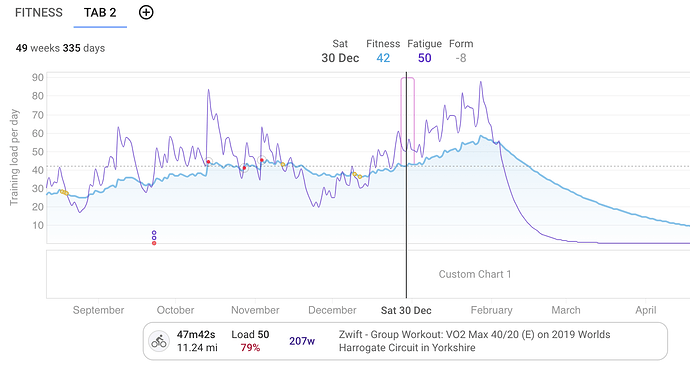Thanks for your answer. But its not ticked. The last workout (today) was without a heartrate Sensor.
Is that a Problem?
If you do “Share chart” but make it private then it doesn’t show up in the search list. The search list is also sorted by usage count. I might change that so newly shared charts get seen a bit more.
The fitness chart adjusts the range to try to show more of the interesting part of the chart and to make space for notes and so on. So if you do a really big activity the fatigue line might be clipped. You can still see the actual value by moving the marker.
Thanks David. If you don’t mind me asking, what’s the point of the Share - Private option? I can’t work out what happens to the chart when you choose that.
It’s the default option for a chart and I need somewhere to make it editable. If you change it to public you might want to change it back to private at some point. Using a verb “Share Chart” maybe not the best text for the button. “Sharing” might be better.
Hey Dadid how are you ?
I change like i mention before , my settings (ski and Row) “Hr , Pace or power” to Power or Pace , HR ; and this is what happen , you have some insight what is missing?
BEFORE ( HR first)
AFTER ( Pace or Power FIrst)
Your response has me curious. How (formula) is the “Load” calculated? I’m looking at designing some workouts
Intervals uses TSS as developped by TrainingPeaks for power based load:
Hey David sorry tobother yu (again)
i find why some errors happen.
calculated my 500/ wrong , but in the zones right. You know how i can correct this?
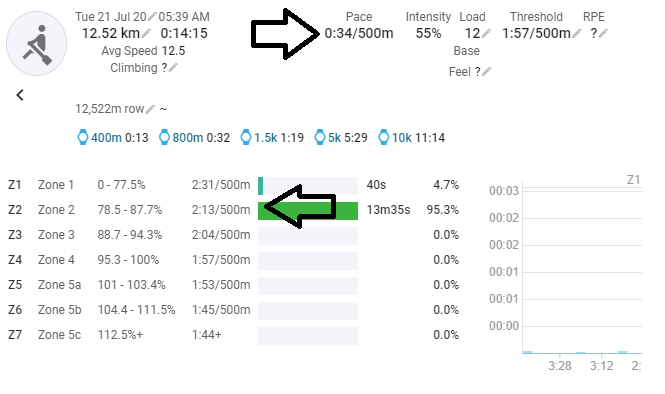
Deleted
Your Fitness chart (PMC) is lying to you; here is why.
A couple of notes/questions:
- The post suggests performing threshold tests often so as to keep a nicely calibrated system. The suggested threshold test for running is a 30-minute all-out time trial, which for less experienced runners could easily result in injury. Do you have any rules of thumb or recommended approaches when it comes to threshold testing?
- The post warns against mixing HR and Pace based TSS calculations. What if for one block you follow an HR based plan and for the next your workouts are set by Pace (or Power)? My intuition tells me that you should only be looking for Fitness or Load values within the same training block. This makes it so that you kind of lose the ability to see your progress over multiple training seasons, but I guess you can use other metrics (like race results!) to gauge progress. Any thoughts?
- Piggybacking on the previous question, there are a lot of training stress metrics available in Intervals.icu: HR/Pace/Power Load, TRIMP, S-RPE, maybe others that I still have not cracked. Do you use a mix of them for different things or just default to the ordering you chose on Settings for Training Load and work solely with that?
These are personally relevant to me as I’m currently base building and mostly guiding my training based on HR but in a couple of weeks I’m looking to graduate to a more intense plan that prescribes workouts by Pace. I’m not sure what adjustments to Training Load or what I should try tracking (on the Fitness graph or elsewhere) to be on top of my progress.
Thanks for the link, it’s important to be reminded that a lot of this is nice to look at (and can be helpful to guide training) but ultimately is only useful if it translates to results.
Some good points that deserve a detailed response. I’ll edit this post later with my response.
Edit:
Before starting, I’m not a runner, let alone a coach for runners, although I have done 2000Km in 2 years ranging from 5Km to 21Km. I do however believe that some cycling-related points can transfer to your questions.
For threshold power (and HR in the same session), I follow an approach of testing at the beginning of the season to establish a baseline, then test again between base and build. The testing/prep phase and base is usually 16-20 weeks (base can be 12-16 weeks), so a lot can change in that time. However, some people don’t have a goal to ride faster, and their base period would be different, in which case testing is not necessarily necessary. Testing before an A race, in my opinion, is also not necessary. I’ve have races where my IF was 1.01 for a 3 hour race, with some people saying my FTP is set too low, which it probably is. The point is that I would’ve last tested before the build phase (9 weeks, plus 2-3 weeks for a peak, taper and race week). A lot can also change during this period too, but testing a few weeks before a race, and having a bad test can leave to someone second guessing their actual performance.
As for the 30-minute duration, when I was running, I found that I only needed to test once I got to a point where I could run for an hour (14 weeks of training: 8 weeks for 0-5km and 6 weeks to get up to running 10Km). I would use pace as the guide, and not HR.
As a cyclist, I have the luxury of power (at least for road riding), but I don’t have a power meter on my MTB and Gravel bikes, so I can only get hrTSS or Load values that I would guess are close to my planned session target load. For me there, RPE, breathing and HR are my ways to pace the efforts, and then rely on seeing how Average HR and HRRc were on the ride. I have dual recorded power & HR on one device, and HR only on another device, then compared the load after each ride. The load values are close enough to be in the ball park, but it’s not exact. I wouldn’t worry about trying to ensure my hrTSS is exact, but rather look to track similar rides where I’m not using power.
In terms on metrics, nothing trumps performance. As Dr Andy Coggan has said, the measure of performance, is performance. Being able to run/ride faster for the same perceived effort, is a sign of improvement. Testing is not necessary to get a benchmark effort. HRRc can be measured using HR only, so there’s a measure of recovery on hard efforts, like hill repeats (VO2 type workouts). I’m not sure that a sprint would get the HR high enough, for long enough, given that sprints are usually below 1-min.
Consistency here is key. Pick one way of measuring and use that as a measure of load.
I am a firm believer of keeping things as simple as possible, and will use a combination of progressive overload and a polarised approach to all training. Keep the easy sessions easy, and use RPE and HR as the primary measurement. Everything else is secondary, and helps to track improvements, eg. more power for the same HR.
Hard sessions are split into sustainable efforts (threshold) with a progressive increase in duration, eg. 20-min FTP test, then 24, 28, 32, 36, 40, 44 and 48 minutes time in zone, with recovery in between. The very hard stuff is full gas, but at a pace I can sustain across each interval. I’m not looking to extend time (extensive) but rather increase intensity (intensive). That said, I might start off with 3 sets, and end with 5 sets, but it depends on how I feel at the start of the build phase.
I hope this has answered everything. If not, feel free to ask.
Everything above is based on my experience, which might align with certain other coaches, and be different from others. What I have done has worked for me, and a few others. It has also not worked for some, and I’ve learnt from that too.
Thank you very much for taking the time to answer!
I still don’t know enough to be able to accurately translate some cycling advice to running, but like you said, a lot of concepts and ideas are similar enough.
I recently changed my Training Load settings to prefer HR over Pace as I was frustrated that most of my (HR prescribed) workouts would be over the Target Load. The change made it so that all of my workouts were a lot more “compliant” with the plan.
I was thinking of changing them back to Pace > HR once I started a plan that prescribes running by pace, and sort of keeping metrics/progress contained to each block. But I agree with you that keeping things simple is the way to go; I’ll probably revert to the default of Pace > HR and keep it like that despite the type of plan I’m following. I guess I just liked seeing the green check marks too much. ![]()
The common arguments I see for this are 1) setting realistic pace goals for your A-race, and 2) testing your kit, fuel strategy, and mental space. I’m guessing these apply to cycling exactly.
It’s obviously not required and a bad performance can psych you out, but it seems like a smart thing to do if you have the option to do it. It seems that there a lot of other benefits to testing a couple weeks out other than setting your FTP accurately (I’m specifically talking about something like doing a B race 4+ weeks before). I know you’ve already touched on this but I’m keen to know some more details about your or your athlete’s experiences.
Maybe this now straying away from the Fitness Page & metrics topic of the thread but I’m happy you shared the link so it could spark some discussion.
This page was intended to be a guide to using the fitness page. There is another discussion on “staying in the green” which has an overlap of the fitness chart, i.t.o. it’s also deceiving if not interpreted correctly. Perhaps we can move the extended discussion to a similar topic or start another.
Good morning, I am a runner who sometimes rides a bike, but since the bike rides are long and slow I get all my fitness graphs messed up, I would like to know if it is possible to ignore the bike activities in the graph and have a fitness graph that only includes running activities.
Thanks
There are a couple of ways to do this.
-
You can ignore training load from your bike activities. This will make it so that these activities don’t count towards your Fitness/Fatigue and will not affect the default Fitness chart . You can do so by selecting Actions → Settings → Ignore time and distance:
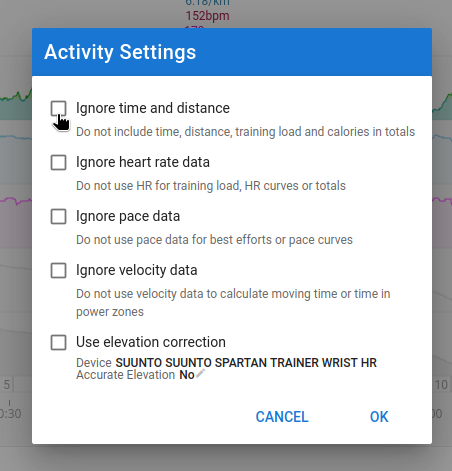
This can be done in bulk through the Activities list page by selecting Edit → Update Settings → Ignore time and distance:
-
You can create a custom chart that will calculate Fitness/Fatigue solely for Running activities:
Notice that the Activity type filter is set to “Run” instead of “All activities”.
Wow! You are awesome, you did a super explanation with images!
Now everything works the way I want it to, thank you very much tlgs!!!
